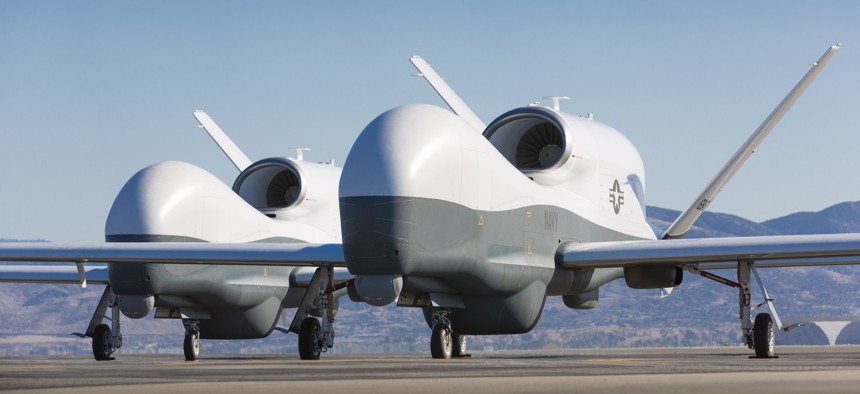
Two MQ-4C Triton Unmanned Air System vehicles at Northrop Grumman. Northrop Grumman
How the Pentagon Nickel-and-Dimed Its Way Into Losing a Drone
The lion’s share of the U.S. drone fleet is easy prey for advanced air defenses. It didn’t have to be that way.
Wednesday’s downing of a U.S. drone by Iran’s Revolutionary Guard exposes a weakness in U.S. operations. The United States has some of the world’s most sophisticated drones for intelligence, surveillance, and reconnaissance. But they were designed for past wars, for use against insurgent forces such as ISIS or the Taliban that cannot track and destroy high-flying aircraft. Iran and other potential adversaries, by contrast, have radar and missiles that can turn some of the U.S. military’s most important drones into expensive, conspicuous targets.
Officials with U.S. Central Command confirmed Thursday morning that the Iranian military had shot down a BAMS-D RQ-4A Global Hawk, an incredibly sophisticated drone that can carry a suite of sensitive and powerful sensors up to 55,000 feet on missions that can last 24 hours. At $130 million apiece (or $220 million, including research and development costs), it’s more expensive than the F-35 Joint Strike Fighter, which costs around $90 million apiece these days. Its single turbofan pushes it to speeds around 400 miles per hour on a 131-foot wingspan that affords long dwell times — and is easily spotted on radar.
On Thursday, Islamic Revolution Guards Corps officials declared that they had shot down the drone with an Iranian-made Khordad-3 air defense system. Given the RQ-4’s usual operating altitude, the interceptor missile was likely a TALASH 2B. A representative from U.S. Central Command declined to confirm the missile type, but did say that Iran did not use its most sophisticated air-defense system, the Russian-made S-300, in the engagement.
In other words, the U.S. military lost one of its most advanced intelligence drones to a mediocre radar and missile. That reflects a lack of suitable next-generation drones to carry out important intelligence and reconnaissance missions against adversaries with actual air defenses.
Related: China’s Beating the US to Market on Combat Drones, By Copying US Technology
Related: US Drones May Soon Run on Open-Source Software
Related: Here's the US Navy’s Drone Tanker, on the Road
The Pentagon has a stealth drone somewhat more suitable for those missions: the RQ-170, one of which the Iranians captured in 2011; seven years later, Tehran was deploying a close copy. And March saw the first flight of a faster, cheaper combat drone called the XQ-58 Valkyrie, intended to work alongside fighter aircraft.
But, in many ways, both projects represent an attempt to regain innovation ground that the U.S. has already ceded. In 2015, the U.S. Navy had a pair of experimental low observable combat drones, the X-47B, from weapons-maker Northrop Grumman. The Navy shelved them in 2015, citing cost, and reoriented the program to develop a drone tanker.
Military technology experts say Wednesday’s shootdown reflects a gap between the military’s current drones and the potential adversaries they face.
“Defense analysts have been arguing for over a decade that the United States needs to bolster its fleet of stealth, combat drones. Unfortunately, the United States has struggled to turn lofty [unmanned aerial system] vision documents into real investments in next-generation uninhabited combat aircraft,” said Paul Scharre, a senior fellow and director of the Technology and National Security Program at the Center for a New American Security. “This is especially true in naval aviation, where the X-47B demonstrator was originally intended to be a bridge to a stealth combat drone.”
“If the U.S. had moved aggressively in developing stealth combat drones a decade ago, it might be in a different place today,” Scharre said.
Michael C. Horowitz, a political-science professor at the University of Pennsylvania, said, “Iran's shootdown of an RQ-4 Global Hawk illustrates the costs of focusing on drones that are neither more capable at the high-end — stealthier, faster, able to defend themselves — or cheaper and more numerous, meaning anyone getting shot down is not a big deal.”
Bottom line, says Horowitz: “Current generation drones simply can't operate effectively in contested airspace. Hopefully, the Air Force's investment in the XQ-58A signals that the military services are starting to recognize the potential of next generation systems, but only time will tell”
The capability gap visible in Wednesday’s engagement over Iran will be even more obvious when the U.S. military has to conduct intelligence operations that aggravate China.
“If the U.S. eventually loses conventional military superiority to China, and capabilities surrounding AI are the reason, we may look back at the Navy's decision to shelve the X-47B and replace it with the MQ-25 [drone tanker] as the canary in the coal mine,” Horowitz said. “The Navy chose not to invest in a next generation, faster, stealthier drone, instead spending their resources on an air to air refueling drone to extend the range of the F-35.”
The United States is now beginning to see the real costs from those decisions, and they are rising.




